After seeing posts from MRTlab (http://en.mrtlab.com) about MRT on various data recovery forums, I was filled with the same skepticism as most other data recovery technicians. The promise of an affordable alternative to PC3000 the King of professional data recovery hardware made by Ace Laboratories (http://www.acelaboratory.com) in Russia, is not the first time it has been heard. For the most part, previous vendors promised big, were very active in the sales process and failed to deliver, both with product updates and support.
With this in mind, I asked the MRTlab team if they had any positive reviews or testimonials from a reputable data recovery lab. As this was not the case, I offered to provide them with an honest review if they would send me a card to test.
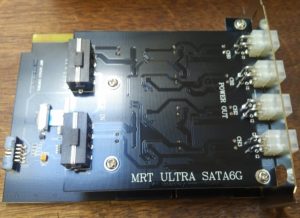 They kindly accepted my offer and sent me an MRT Ultra card, all the accessories and a couple months of credit for the online version of the program.
They kindly accepted my offer and sent me an MRT Ultra card, all the accessories and a couple months of credit for the online version of the program.
My initial observation is that things look very familiar to my PC3000 Express, but different enough to know that there was some original thought put into the design. My only complaints about the supplied hardware are that the SATA cables could be longer and the lack of supplies needed to interface with the PATA port. The dual head terminal is a nice concept, but it might be an issue when connecting a second drive and accidentally pulling out the first. The short SATA cables are easily resolved for a few bucks on my own, MRTlab has already addressed the lack of PATA supplies and will now supply them with the systems and the dual terminal issues might be resolved with longer ribbon cables for the separate ports.
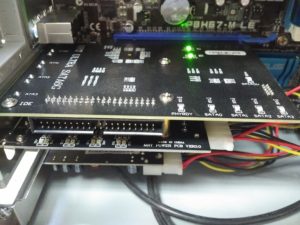
MRT Ultra 4 SATA Port / 1 PATA Port Card
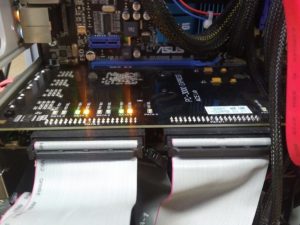
PC3000 Express 4 SATA Port / 2 PATA Port Card
The software installation is quite simple. Go to the MRTlab website, download the latest version of the software for the version of hardware you have. The initial registration process required me to setup an account on their VIP site and notify them of my new account and card serial number so that they could link the two manually. I believe that this has since been automated with their newly updated VIP site (http://vip.mrtlab.com/en/).
The VIP site is where you go to recharge your offline card for extended use, now in ½ month increments, if you’d like.
The software interface is, again, quite familiar to PC3000 with how each brand and series of drive access its brand specific utility. The menus and wording are quite different, and somewhat confusing at times. But, overall, the familiar interface helps speed up the learning curve for those who are already accustomed to PC3000.
MRT’s DE (Data Explorer) is similar to PC3000’s DE (Data Extractor), but they do approach things quite differently. Data Explorer has a long way to go to compete with Data Extractor as it still only support NTFS and FAT based file systems. But, if you aren’t concerned about targeting the used sectors by the file system within the imaging facility, it is more than capable of getting a full sector-by-sector image of your failing hard drive.
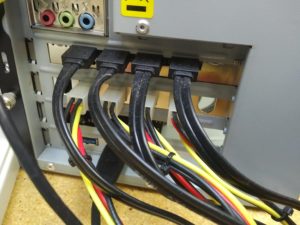
MRT Ultra 4 SATA Port / 1 PATA Port Rear Connectors
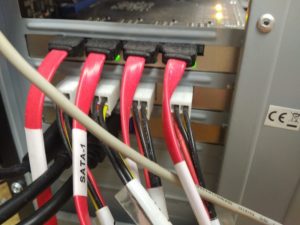
PC3000 Express 4 SATA Port / 1 PATA Port Rear Connectors
I will dig into the inner workings of Data Explorer in a future blog post focused on it alone, as well as separate blogs about each of the brand specific utilities.
One concern that I hear from other data recovery technicians is whether or not MRT is here to stay and will provide the support and updates that were seriously 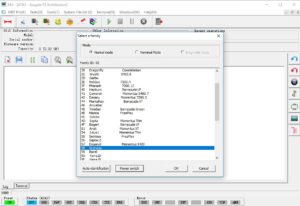 lacking in the other products who have failed before them. I ran into some issues with my system right away that required some back and forth correspondence and remote support. But, because of the 13 hour time difference and slow responses to questions, I was beginning to think there was no hope. However, after some correspondence with Wendy in sales, we were able to arrange a time for remote support within my working hours. At the end of it all, it was me who figured out that the issues were not with MRT itself, but rather with Trend Micro’s behaviour monitoring system blocking MRT from completing various tasks.
lacking in the other products who have failed before them. I ran into some issues with my system right away that required some back and forth correspondence and remote support. But, because of the 13 hour time difference and slow responses to questions, I was beginning to think there was no hope. However, after some correspondence with Wendy in sales, we were able to arrange a time for remote support within my working hours. At the end of it all, it was me who figured out that the issues were not with MRT itself, but rather with Trend Micro’s behaviour monitoring system blocking MRT from completing various tasks.
On the side of support, there is definitely a huge need for growth if they want to appeal to the Western market (Europe and North America). They are already working to improve in this area, but I suspect that they will continue to struggle in this area if they cannot get the sales in these markets to sustain the necessary support team.
So, what is my overall opinion of the MRT Ultra system? I can see a future for MRT, not as a competitor to PC3000, but as the product that can fill a niche in a few areas.
- The first area is for those who want to do data recovery recreationally, learn data recovery or just test the waters without significant investment. With the online version of the card, the full cost can be deferred for as long as is needed. You can pay to charge and use the card for 2 months, let it expire for 6 months, recharge it for ½ a month and so on. They will keep track of the amount paid and when the card is paid off, it will convert to the full offline version and require no further payments. If you choose to sell the card, the license is transferrable and the amount credited to the card transfers too.
- The second area is for data recovery training. It would be very costly to have many PC3000 systems available for a weekend training session. But, one could easily wrap a few hundred bucks into the training cost to have an MRT system online for the training session.
- The third area is for those who already do data recovery and have one or more PC3000 systems and are looking for another system to ease the load. By moving tasks over to MRT, it frees up PC3000 channels for the tasks that are not supported by MRT or other tools.
This concludes my overall opinion of the MRT Ultra system. Feel free to post questions in the comments section of this post or in our data recovery forums. I’ll either answer them right away or include them in the upcoming follow-up reviews.
I’m interested to hear more. I can’t imagine that it will be a PC3000 substitute for complicated work, or where support is required. However, if it has decent disk imaging capabilities with support for good filesystem reconstruction, then it might be of use to take the load of the PC3000 units particularly when dealing with slow imaging high capacity HDDs.
As of right now, the disk imaging functions are fine, providing that you are don’t want good file system reconstruction or file verification. We are holding off on reviewing their imaging module (DE) and individual modules until a promised update is released April 2017.